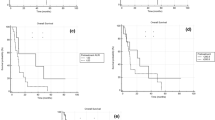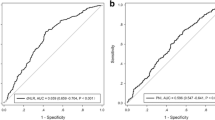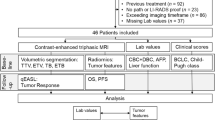Abstract
Purpose
To evaluate the ability of neutrophil-to-lymphocyte ratio (NLR), platelet-to-lymphocyte ratio (PLR), aspartate aminotransferase-to-lymphocyte ratio (ALRI) and systemic-inflammation index (SII) to predict clinical outcomes in hepatocellular carcinoma (HCC) patients undergoing transarterial radioembolization (TARE).
Materials and Methods
One hundred forty-five patients who underwent treatment of 167 HCCs had their pretreatment and 1 month post treatment laboratory values evaluated. Overall survival (OS), progression-free survival (PFS) and local PFS models were performed with patients separated by median inflammatory scores.
Results
The median pretreatment NLR, PLR, ALRI and SII were 3.0 (range: 0.5–176), 104.4 (range: 25–830), 55.7 (range: 7.5–2090) and 360.2 (range: 51.1–7207.8), respectively. While the median post treatment NLR, PLR, ALRI and SII were 6.2 (range: 0.4–176), 180 (range: 35–2100), 125 (range: 15.9–5710) and 596.8 (range: 28.9–19,320), respectively. OS models showed significant differences when separating the groups by median post treatment NLR (p = 0.003) and SII (p = 0.003). Multivariate Cox regression models for OS with all pre and post treatment inflammatory markers (log-scale) as well as tumor size, AFP and Child–Pugh score showed significant pretreatment NLR [HR: 0.22 (95% CI:0.06–0.75), p = 0.016] and SII [3.52 (95% CI: 1.01–12.3), p = 0.048], as well as post treatment NLR [6.54 (95% CI: 1.57–27.2), p = 0.010] and SII [0.20 (95% CI: 0.05–0.82), p = 0.025] association. The post treatment ALRI (p = 0.010) correlated with PFS while, post treatment NLR (p < 0.001), ALRI (p = 0.024) and SII (p = 0.005) correlated with local PFS.
Conclusion
Pretreatment and post treatment NLR and SII may be associated with OS and post treatment ALRI may be associated with both PFS and local PFS in HCC patients undergoing TARE.






Similar content being viewed by others
References
Torre LA, Siegel RL, Ward EM, Jemal A. Global cancer incidence and mortality rates and trends—an update. Cancer Epidemiol Prev Biomark. 2016;25(1):16–27.
Salem R, Gordon AC, Mouli S, et al. Y90 radioembolization significantly prolongs time to progression compared with chemoembolization in patients with hepatocellular carcinoma. Gastroenterology. 2016;151(6):1155–63.
Garin E, Tselikas L, Guiu B, et al. Personalised versus standard dosimetry approach of selective internal radiation therapy in patients with locally advanced hepatocellular carcinoma (DOSISPHERE-01): a randomized, muticentre, open-label phase 2 trial. Lancet Gastroenerol Hepatol. 2021;6(1):17–29.
Salem R, Johnson GE, Kim E, et al. Yttrium-90 radioembolization for the treatment of solitary, unresectable hepatocellular carcinoma: the LEGACY study. Hepatology. 2021. https://doi.org/10.1002/hep:31819. (epub ahead of print).
Finn RS, Qin S, Ikeda M, et al. Atezolizumab plus bevacizumab in unresectable hepatocellular carcinoma. N Engl J Med. 2020;382(20):1894–905.
Young S, Taylor A, Golzarian J, et al. Clinical utility of one month imaging following selective internal radiation therapy. Diagn Interv Imaging. 2019;100(1):39–46.
Faria SS, Fernandes PC, Silva MJB, et al. The neutrophil-tolymphocyte ratio: a narrative review. Ecancermedicalscience. 2016;10:702.
Lai Q, Vitale A, Manzia TM, et al. Platelets and hepatocellular cancer: bridging the bench to the clinics. Cancers. 2019;11(10):1568.
Li S, Feng X, Cao G, Wang Q, Wang L. Prognostic significance of inflammatory indices in hepatocellular carcinoma treated with transarterial cheomebolization: A Systematic review and meta-analysis. PLoS ONE. 2020;15(6):e0230879.
Wang C, Wang M, Zhang X, et al. The neutrophil-to-lymphocyte ratio is a predictive factor for the survival of patients with hepatocellular carcinoma undergoing transarterial chemoembolization. Ann Transl Med. 2020;8(8):541.
Sullivan K, Groeschl R, Turaga K, et al. Neutrophil-to-lymphocyte ratio as a predictor of outcomes for patients with hepatocellular carcinoma: a Western perspective. J Surg Oncol. 2014;109(2):95–7.
Jin J, Zhu P, Liao Y, Li J, Liao W, He S. Elevated preoperative aspartate aminotransferase to lymphocyte ratio index as an independent prognostic factor for patients with hepatocellular carcinoma after hepatic resection. Oncotarget. 2015;6:19217–27.
Hu B, Yang XR, Xu Y, et al. Systemic immune inflammation index predicts prognosis of patients after curative resection for hepatocellular carcinoma. Clin Cancer Res. 2014;20:612–22.
Sukato DC, Tohme S, Chalhoub D, et al. The prognostic role of neutrophil-to-lymphocyte ratio in patients with unresectable hepatocellular carcinoma treated with radioembolization. J Vasc Interv Radiol. 2015;26(6):816–24.
Estrade F, Lescure C, Muzellec L, et al. Lymphocytes and neutrophil-to-lymphocyte ratio variations after selective internal radiation treatment of HCC: a retrospective cohort study. Cardiovasc Intervent Radiol. 2020;43(8):1175–81.
Li X, Montazeri SA, Paz-Fumagalli R, et al. prognostic significance of neutrophil to lymphocyte ratio dynamics in patients with hepatocellular carcinoma treated with radioembolization using glass microspheres. Eur J Nucl Med Mol Imaging. 2021. https://doi.org/10.1007/s00259-020-05186-7. (epub ahead of print)
Yoneoka G, Bozhilov K, Wong LL. Prognostic ability of inflammation-based markers in radioembolization for hepatocellular carcinoma. Hepatoma Res. 2020;6:67.
Taussig MD, Irene Koran ME, Mouli SK, et al. Neutrophil to lymphocyte ratio predicts disease progression following intra-arterial therapy of hepatocellular carcinoma. HPB (Oxford). 2017;19(5):458–64.
Yang Z, Zhang J, Lu Y, et al. Aspartate aminotransferase-lymphocyte ratio index and systeimic immune-inflammation index predict overall survival in HBV-related hepatocellular carcinoma patients after transcatheter arterial chemoembolization. Oncotarget. 2015;6(40):43090–8.
Yang Z, Zhang J, Lu Y, et al. Aspartate aminotransferase-lymphocyte ratio index and systemic immune-inflamation index predict overall survival in HBV-related hepatocellular carcinoma patients after transcatheter arterial chemoembolization. Oncotarget. 2015;6:43090–8.
Lu LH, Wei W, Li SH, Zhang YF, Guo RP. The lymphocyte-C-reactive protein ratio as the optimal inflammation-based score in patients with hepatocellular carcinoma underwent TACE. Aging. 2021;13(4):5358–68.
Venkatesulu BP, Mallick S, Lin SH, Krishnan S. A systemic review of the influence of radiation-induced lymphopenia on survival outcomes in solid tumors. Crit Rev Oncol Hematol. 2018;123:42–51.
Carr BI. Hepatic arterial 90Yttrium glass microspheres (Therasphere) for unresectable hepatocellular carcinoma: interim safety and survival data on 65 patients. Liver Transpl. 2004;10:S107-110.
Salem R, Lewandowski RJ, Atassi B, et al. Treatment of unresectable hepatocellular carcinoma with use of 90Y microspheres (TheraSphere): safety, tumor response, and survival. J Vasc Interv Radiol. 2005;16(12):1627–39.
Dunfee BL, Riaz A, Lewandowski RJ, et al. Yttrium-90 radioembolization for liver malignancies: prognostic factors associated with survival. J Vasc Interv Radiol. 2010;21(1):90–5.
Salem R, Johnosn GE, Kim E, et al. Yttrium-90 radioembolization for the treatment of solitary, unresectable hepatocellular carcinoma: the LEGACY study. Hepatology. 2021. https://doi.org/10.1002/hep.31819. epub ahead of print
Filippiadis DK, Binkert C, Pellerin O, Hoffman RT, Krajina A, Pereira PL. Cirse quality assurance document and standards for classification of complications: the cirse classification system. Cardiovasc Intervent Radiol. 2017;40(8):1141–6.
Ding PR, An X, Zhang RX, et al. Elevated preoperative neutrophil to lymphocyte ratio predicts risk of recurrence following curative resection for stage IIA colon cancer. Int J Colorectal Dis. 2010;25(12):1427–33.
Ohtani H. Focus on TILS: prognostic significance of tumor infiltrating lymphocytes in human colorectal cancer. Cancer Immun. 2007;7:4.
Kuang DM, Zhao Q, Wu Y, et al. Peritumoral neutrophils link inflammatory response to disease progression by fostering angiogenesis in hepatocellular carcinoma. J Heaptol. 2011;54(5):948–55.
Mouchli M, Reddy S, Gerrard M, Boardman L, Rubio M. Usefulness of neutrophil-to-lymphocyte ratio (NLR) as a prognostic predictor after treatment of hepatocellular carcinoma. 2021. https://doi.org/10.1016/j.aohep.2020.08.067. Epub 2020 Sep 5
Llovet JM, Real MI, Montana X, et al. Arterial embolization or chemoembolization versus symptomatic treatment in patients with unresectable hepatocellular carcinoma: a randomized controlled trial. Lancet. 2002;359:1734–9.
Lo CM, Ngan H, Tso WK, et al. Randomized controlled trial of transarterial lipiodol chemoembolization for unresectable hepatocellular carcinoma. Hepatology. 2002;35:1164–71.
Acknowledgements
Research reported in this publication was supported by National Institute of Health grant P30 CA77598 utilizing the Biostatistics and Bioinformatics Core shared resource of the Masonic Cancer Center, University of Minnesota and by the National Center for Advancing Translational Sciences of the National Institutes of Health Award Number UL1-TR002494. The content is solely the responsibility of the authors and does not necessarily represent the official views of the National Institutes of Health.
Funding
This study was not supported by any funding. SY is a consultant for Boston Scientific. JG and DD are consultants for Sirtex Medical.
Author information
Authors and Affiliations
Corresponding author
Ethics declarations
Conflict of interest
Shamar Young, Nathan Rubin, Donna D′Souza, Pranav Sharma, John Pontolillio, Siobhan Flanagan, Jafar Golzarian, Tina Sanghvi declare that they have no conflict of interest.
Human and Animal Rights
All procedures performed in studies involving human participants were in accordance with the ethical standards of the institutional and/or national research committee and with the 1964 Helsinki declaration and its later amendments or comparable ethical standards.
Informed Consent
For this type of study formal consent is not required. This study has obtained IRB approval from University of Minnesota IRB and the need for informed consent was waived. For this type of study consent for publication is not required.
Additional information
Publisher's Note
Springer Nature remains neutral with regard to jurisdictional claims in published maps and institutional affiliations.
Rights and permissions
About this article
Cite this article
Young, S., Rubin, N., D’Souza, D. et al. Inflammatory Scores: Correlation with Clinical Outcomes in Hepatocellular Carcinoma Patients Undergoing Transarterial Radioembolization. Cardiovasc Intervent Radiol 45, 461–475 (2022). https://doi.org/10.1007/s00270-022-03080-8
Received:
Accepted:
Published:
Issue Date:
DOI: https://doi.org/10.1007/s00270-022-03080-8




